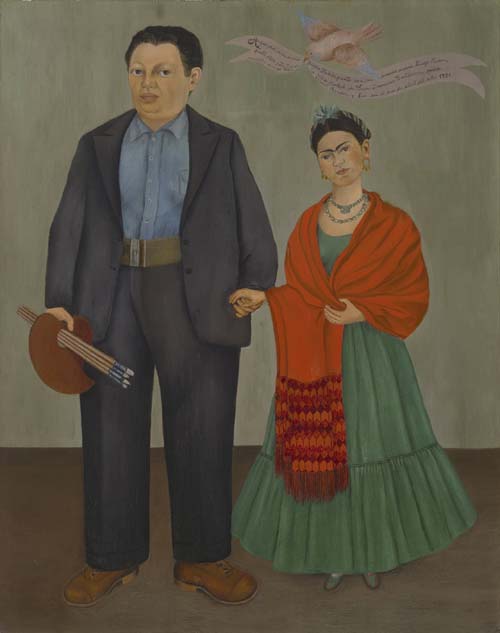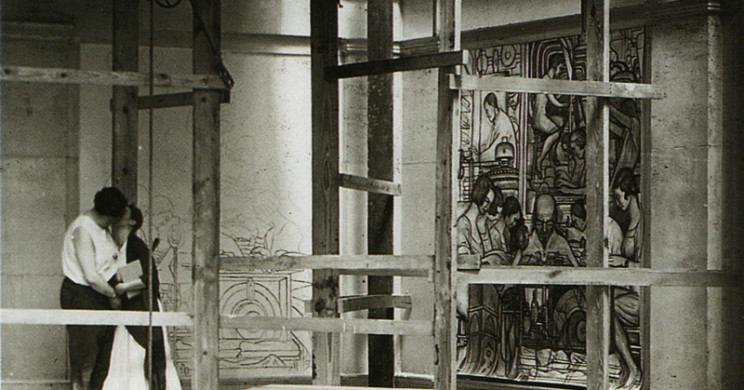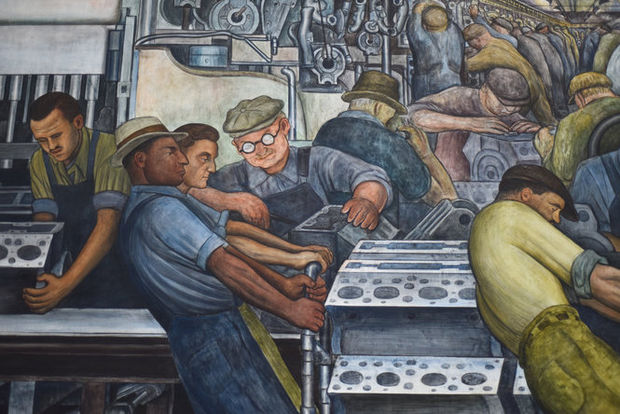There are a lot of thrills in “Diego Rivera and Frida Kahlo in Detroit,” a tightly focused exhibition exploring the 11 months that the married couple spent working here in 1932-33.
But what’s most exhilarating about the show, which opens Sunday at the Detroit Institute of Arts, transcends the numerous knock-out works by both artists. And it goes beyond the deeper understanding that emerges of their relationship to each other, their shared Mexican roots and the impact that Detroit had on their lives and art.
As the first major exhibition since Detroit exited bankruptcy, the show carries a celebratory aura that’s hard to describe but will feel palpable to anyone who rode the roller-coaster of emotions with the DIA saga during the bankruptcy. It’s a victory lap for a museum — and a city — that spent most of the last two years in an existential crisis, fighting to protect its irreplaceable treasures from liquidation.
Walking through the galleries reminds you just how close Detroit came to losing a cornerstone of its cultural soul — especially because the creation of the DIA’s signature work, Rivera’s magnificent “Detroit Industry” murals, is one of the central narratives of the show. The political parallels and divergencies between then and now are unavoidable.
Of course, the timing is serendipitous. The Rivera-Kahlo show has been in the works for years, long before anyone knew how or when the cliff-hanger might end. Had the winds blown differently, the exhibition might instead seem more like a last meal before the march to the scaffold.
When Rivera and Kahlo arrived in Detroit at the height of the Great Depression, the city-owned museum was struggling to stay open, although a close read of evidence shows no serious talk of selling the art. Visionary director William Valentiner invited Rivera to Detroit and Edsel Ford put up the artist’s eye-popping fee of $20,000 ($350,000 in today’s dollars).Rivera and Ford — the communist and the capitalist — looked like an odd couple, but they shared common ground, mutual respect and convergent agendas. Both believed industry was a key to human progress, both believed in the power of art to change lives. Ford, a cultured man and enlightened industrialist, also may have seen the commission as a peace-making gesture with labor at a time when Ford security guards and Dearborn police shot and killed five unarmed workers and injured dozens of others in a hunger protest. Rivera believed his revolutionary art could reform capitalism from inside the belly of the beast.

Frida Kahlo, “Frieda and Diego Rivera” (1931), oil on canvas, 39 3/8 x 31 in, San Francisco Museum of Modern Art, Albert M. Bender Collection, Gift of Albert M. Bender (all images courtesy Detroit Institute of Arts unless otherwise noted)
But never forget how brave and farsighted Valentiner and Ford were in turning a mid-career contemporary artist and self-described Marxist loose on the DIA’s central courtyard to depict Detroit history. The DIA had only moved into its Paul Cret-designed Beaux Arts home on Woodward Avenue five years earlier in 1927. Would any leadership at any American museum today take such a risk?
Organized by DIA adjunct curator of contemporary art Mark Rosenthal, “Diego Rivera and Frida Kahlo in Detroit” includes about 65 paintings, drawings and prints. Brief summaries of the artists’ trajectories before and after their time in Detroit frame a hefty central chapter on work created in the city.
There are regrettable omissions — no example of Rivera’s trenchant early abstract cubist works, no mention of other relevant art history currents like surrealism, no reflection of Kahlo’s posthumous rise to feminist sainthood or pop culture status. Still, Rosenthal’s selection of work and detailed interpretive arguments in his sharp catalog essay are illuminating. The bonus of remarkable historical film footage, including Rivera at work at the DIA, adds to the time-capsule vibe.
The artists were at separate points in their lives and careers in 1932. Rivera, 45, was at the peak of his international fame and powers as a muralist; Kahlo, 24, was just beginning to establish her artistic identity. For most of the exhibition they work in separate cocoons: Rivera on the public stage, Kahlo looking inward, translating her private emotional and physical pain into intimate pictures of shattering emotion.Rivera plots an incredibly sophisticated program for the 27-panel fresco cycle he will paint across the four walls of the courtyard. It’s so damn exciting to see his ideas coalesce in the rarely seen and breathtaking life-size preparatory drawings for the murals. These charcoal-and-pigment works reinforce Rivera’s intelligence, ambition and masterful draftsmanship — look at the expressive confidence of his lines and weight of his curvacious forms.
The murals depict the heroism of the Ford assembly line workers, a subject close to Rivera’s proletarian heart. But he also integrates science, medicine, biology, industry into a utopian synthesis of North American industrial might and Mexican spiritualism. Dualities percolate: Poisonous gas bombs and life-saving vaccines, the soulless mechanization of labor and the promise that mass production of products like cars will elevate lives of common folk.
Rivera’s worldview was complicated and contradictory, but the fundamental optimism that shines through “Detroit Industry” is striking. After Rivera left Detroit for New York, where his Rockefeller Center mural was destroyed for its inclusion of the Soviet leader Lenin, Rivera’s outlook darkens. In the revealing watercolor “Mechanized Motherhood,” Rivera inserts a cubist-like machine into a mother’s womb to symbolize capitalist exploitation.
Kahlo made five paintings in Detroit, and the DIA has gathered three of them, as well as numerous other drawing and paintings. The gender-bending “Exquisite Corpse” pencil drawings she made in 1932 suggest an artist on the brink of something. But what?
Rivera implored his wife to paint her life. Kahlo suffered a miscarriage in July and the painting she soon made, “Henry Ford Hospital,” remains definitive: a beautiful nightmare in which she lies naked on a bed in a pool of blood, six umbilical cords connected to hovering symbols, including a fetus. The images of Detroit factories manifest Kahlo’s own radical politics, connecting the dots between her tragedy and the evils of capitalism.
Kahlo’s formal command sharpened after Detroit. The famous “Self-Portrait with Cropped Hair” and hallucinatory “Suicide of Dorothy Hale” gain power from a concentrated authority and seductive marriage of the confessional and the impervious. It’s the same attitude of countless modern celebrities, among them Madonna (a Kahlo collector). No wonder Kahlo has been embraced by pop culture.
But Rivera still remains the bigger star in Detroit. When “Detroit Industry” opened to the public, religious leaders called the murals blasphemous and obscene and many upper-crusters objected to the artist’s lefty politics. Newspapers called for the murals to be whitewashed. But Ford spoke in defense of art, and working men vowed to form a protective shield around Rivera’s masterpiece.
Eighty years later, the community again rallied to the defense of art, as foundations, civic leaders and state politicians forged a grand bargain of $816 million to protect the DIA from municipal creditors. The DIA, especially the murals, is indivisible with the identity of Detroit as a tough, hard-working city that can take a punch.
————————————————-
The review was published by Mark Stryker for Detroit Free Press.

























